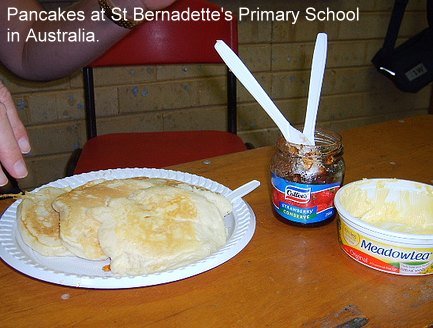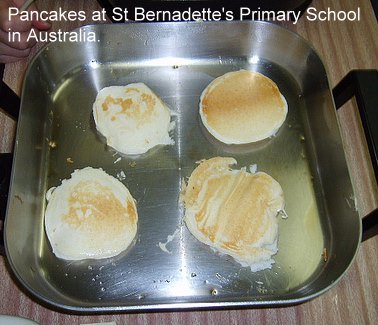| British Culture homepage |
| Search |
| Calendars |
Easter Facts |
| What is Easter ? |
| Easter Dates |
| Shrovetide |
| Shrove Tuesday |
| Pancake Day in England |
| Around the World |
| English pancake recipe |
| Ash Wednesday |
| Lent |
| Mothering Sunday |
| Holy Week |
| Palm Sunday |
| Maundy Thursday |
| Good Friday |
| Holy Saturday |
| Easter Day |
| Easter Monday |
| Easter Customs |
| Easter Eggs |
| Easter Food |
| Unusual Events |
| Easter Superstitions |
| Easter Recipes |
| Pancake recipe |
| Simnel Cake Recipe |
| Easter Activities |
| Easter Quiz |
| Teaching Resources |
|
How Pancake day is celebrated in some other countries around the World
|
|
Woodlands Junior School is in the south-east corner of England |
|
|
Pancake Day, also known as "Shrove Tuesday", "Mardi Gras" or "Fat Tuesday" is celebrated all over the world with fun, games, and of course a lot of eating. The different names reflect the differences in customs that have developed over the years in various places around the world. Some of our visitors have emailed us to tell our students how Pancake Day is celebrated in their country.
What happens on Shrove Tuesday in your country? Pancakes in Australia are too thick to roll. Year 1 at St Bernadette’s Primary school enjoyed eating pancakes in the classroom on Pancake Day. Click here to visit their blog
The photos show pancakes known as pikelets: smaller, thicker version of the pancake, which are served cold with butter or jam and cream.
Australian pancakes are generally a little thicker than English ones but are still able to be rolled. What happens on Pancake Day in Christine Baker emailed to tell us about bun day in Denmark . "In Denmark we also indulge before the beginning of lent. Although not many people fast for lent these days, it’s a welcome excuse to indulge… We celebrate on the last Sunday before lent, so the Sunday before Shrove Tuesday. The day is called "Fastelavn". On this day it is custom to eat Danish style buns with the middle taken out and then filled with whipped cream and/or jam. All the kids dress up in any way they like. Some are cats, pirates, princesses or Shrek, to name a few options. The kids all meet up to "hit the cat out of the barrel", which is the old days included bashing a barrel with a bat while there was a live cat inside. Fortunately for the cats, this is no longer the case, and the barrels are instead filled with sweets. The kids bash the barrel until it breaks and then run to get the sweets that are lying on the snow. The two kids to do the best bashin are crowned Cat King and Cat Queen. Afterwards there is usually hot chocolate and more filled buns for kids and grown ups alike."
What happens on Pancake Day in Sweden? Anne-Lin Hedstrom Tsang emailed to tell us about what happens on Shrove Tuesday in
"Another tradition in Sweden is to eat Pea soup with pancakes afterwards and on every Thursday all year round." What happens on Pancake Day in Canada Jennifer Noseworthy wrote to tell us about what happens on Shrove Tuesday in "We add things to our pancakes such as coins, pieces of string, nails, wedding rings, buttons… all cleaned of course ha ha" The lucky one to find coins in their pancake will be rich, the finder of the ring will be the first married, the finder of the name will become a carpenter and the finder of the thimble will be a seamstress or tailor. "Everyone here looks forward to Pancake Day. Pancakes are served with syrup, partridgeberry jam and sausages." Gwen wrote to us to tell us about Pancake Tuesday in Toronto, Canada. "We are having Pancake Tuesday at our Church in Toronto. The men of the congregation get together and make the batter and do all the cooking. We also serve bacon. We charge a nominal fee and this money goes to street outreach – Sanctuary. " In France, Shrove Tuesday is called Mardi Gras or Fat Tuesday. The name Fat Tuesday comes from the ancient custom of parading a fat ox through Paris on this day. The ox was to remind the people that they were not allowed to eat meat during Lent. During the Mardi Gras Carnival people disguise themselves and put on crazy masks. The Carnival in Nice, France, is a wild 10-day celebration featuring daily parades, concerts, street theatre and more. People wear giant masks. When is the main Pancake eating day in France? Across the Channel in France the main day eating pancakes is Candlemas on the 2nd of February. This holy day is six weeks after Christmas and is the day that Christ was presented at the temple by his mother. Marie-Jeanne emailed to tell us about what happens on Pancake Day in France: We have a saying which says: "Eating crêpes on Candlemas Day (2nd February) "The French name for Candlemas, “Chandeleur” comes from the word “Chandelle” which means candle. It was custom for the people to bring back the lighted candles from church to assure good crops for the year to come and to chase the evil. In France it is custom to prepare “Crêpes” for “La chandeleur”, which symbolises, wealth, good crops and health for the year to come. Its form and colour evoke the Sun which is finally returning after the dark winter. It keeps the mould away from the crop and protects the home from harm. Pancakes must be tossed with a coin in the hand so as to ensure prosperity throughout the year. Whoever manages to toss his pancake without dropping it on the ground will have good luck until the next Candlemas. Also, it is said that Pope Gelasius I, who introduced Candlemas into the Catholic Church, often gave crêpes to people who made the pilgrimage to Rome." Wojtek wrote to tell us about Pancake day in Poland "In Poland, Shrove Tuesday is "Sledziowka" ("sledz" is a herring in Polish). The most popular dish on that day is herring in various styles. Polish people organize parties to celebrate the end of the Carnival. The parties finish at midnight when the official period of Lent begins with Ash Wednesday. Doughnuts and "faworki" are eaten on the last Thursday before Ash Wednesday. There are a lot of competitions choosing the most delicious doughnuts and the press is full of information on the results of various degustations giving assessments of particular bakeries and doughnut producers by more or less dignified juries. " |
|
 © Copyright – please read © Copyright – please read All the materials on these pages are free for homework and classroom use only. You may not redistribute, sell or place the content of this page on any other website or blog without written permission from the . |
Follow projectbritain on Twitter | :Follow on Twitter
© Copyright 2013
is the creator of the Woodlands Resources section of the Woodlands Junior website.
The two websites projectbritain.com and primaryhomeworkhelp.co.uk are the new homes for the Woodlands Resources.
left Woodlands in 2003 to work in Kent schools as an ICT Consulatant.
She now teaches computers at The Granville School and St. John’s Primary School in Sevenoaks Kent.



 "In Sweden it is called Fettisdagen (Fat Tuesday). We eat a Fettisdag buller. This is a round bun with the middle part scooped out and replaced with Marzipan with whipped cream. The top of the bun is placed back on sprinkled with icing sugar."
"In Sweden it is called Fettisdagen (Fat Tuesday). We eat a Fettisdag buller. This is a round bun with the middle part scooped out and replaced with Marzipan with whipped cream. The top of the bun is placed back on sprinkled with icing sugar."

